Pricing Your Products the Right Way with the Van Westendorp Price Sensitivity Meter (Updated)
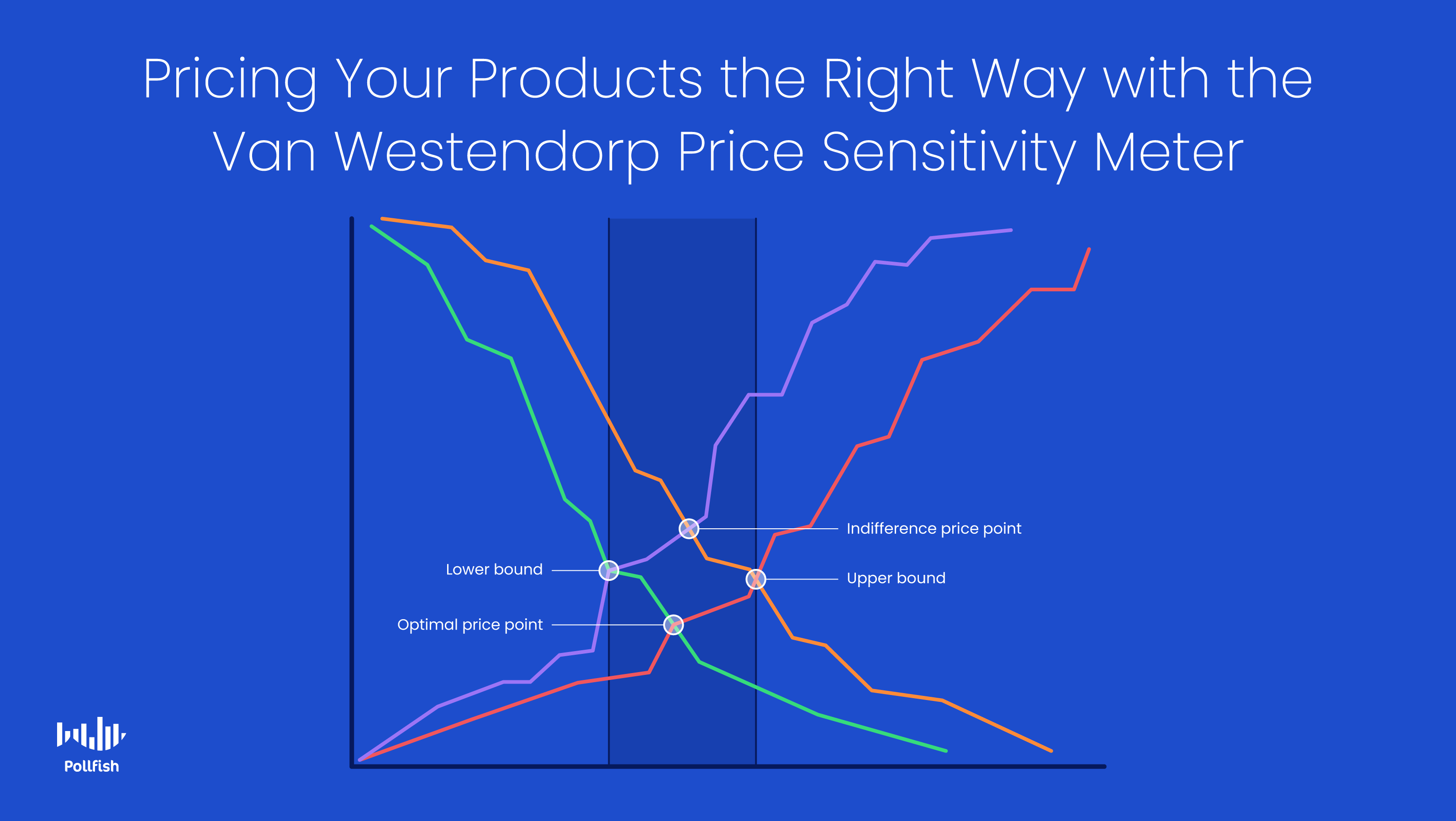 The Van Westendorp Price Sensitivity Meter is an essential market research tool for determining the price of a new product or tweaking that of an existing product.
The Van Westendorp Price Sensitivity Meter is an essential market research tool for determining the price of a new product or tweaking that of an existing product.
It allows businesses of varying sizes and industries to set the proper price of their offerings, one that is in line with customer expectations. After all, pricing is a key aspect of a product’s success.
When it comes to the success of a product or service, everything comes second to price. While this may appear to be an exaggeration, it rings true, especially during the pandemic. Consumers are now more price-conscious than ever before.
In fact, 45% of consumers switched brands to save money in the past year. Consumers are well aware of any signs of inflation, as 77% of consumers have noticed higher prices and over half of consumers are shopping at multiple businesses to find the best price — 53% of customers research multiple stores in search of the best price, specifically.
Fortunately, although it is only February, we’ve got another feature making the rounds on the Pollfish online survey platform. The Van Westendorp Price Sensitivity Meter enables researchers to research customers’ willingness to pay for products and services.
This article explains what the Van Westendorp Price Sensitivity Meter is, its importance, what it is like on Polllfish and more.
Understanding the Van Westendorp Price Sensitivity Meter
Also called the Van Westendorp Price Sensitivity Analysis (PSA) in addition to the Price Sensitivity Meter (PSM), this is a pricing model that provides data for decision-making in regard to consumer price preferences. As such, it is used to determine customers’ willingness to pay a range of prices.
In doing so, it helps conclude the prices that your target market deems acceptable, too high, too low and optimal.
The PSA entered the market research sphere in 1976 by the Dutch economist Peter Van Westendorp. This approach is still in use throughout the market research industry, particularly for product development and to aid pricing strategies.
The meter itself is a visualization in the form of a graph, which presents ratings on price and value from customers. This data is presented by way of responses to survey questions that focus on the prices of different products and services.
This way, researchers and business owners can understand whether their pricing is too high or too low.
The Importance of the Van Westendorp Price Sensitivity Meter
The Price Sensitivity Meter is important on a number of accounts.
First off, it clearly lays out a wide range of price points in relation to how customers feel about them. As the introduction proves with several statistics and editorial sources, pricing is one of the most of not the most important factors when it comes to product success.
Consumers are more conscious than ever due to inflation and other economic downturns brought about by the Covid-19 pandemic. What makes sense to business owners or product marketers does not always align with the expectations and customer buying behavior of customers.
Therefore, businesses should always stay in the know of their customers and this applies to their thoughts, hopes and aversions to different price ranges and points. The PSM is an easy way to access this necessary consumer sentiment.
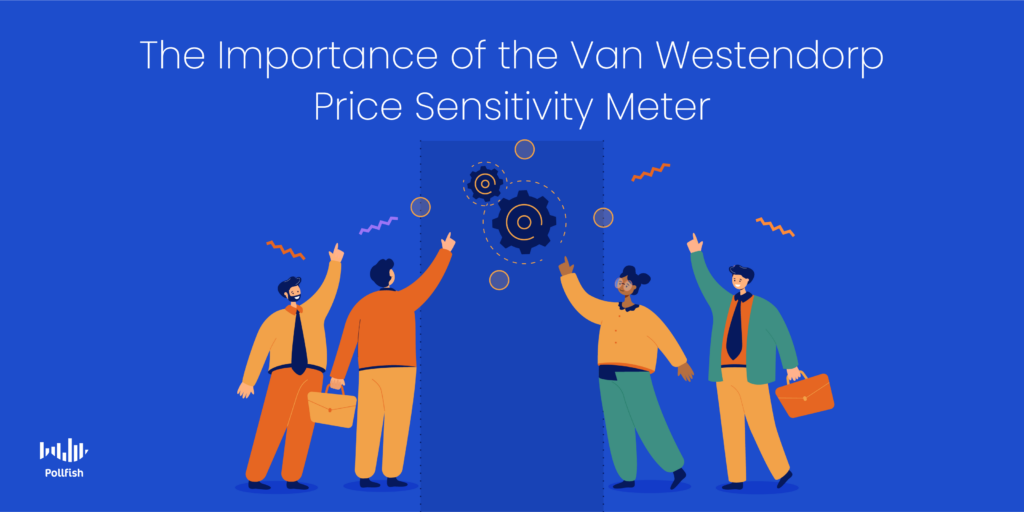
When it comes to going to market, it is crucial to have a deep understanding of how customers value a product and they view its accompanying price. If you don’t, you will certainly disappoint many current and prospective customers, as there will be less of a demand for your product.
In this way, satisfying your customers with good pricing helps you both maintain and increase your customer retention rate along with helping you avoid raising your customer acquisition cost.
While conducting secondary research is a good starting point, it does not provide you with concrete information on your own customers and products, no matter how similar other products in your niche are to yours. Thus, the PSM is a useful tool, as it provides you firsthand information on your own customers and their thoughts about specific prices and products.
The PSA technique is also important, as it is often used during the new product phase, such as in the customer development process to assist you in setting the right price. In this case, the van Westendorp PSM uncovers a potent entry price strategy.
When it comes to established brands and existing products, the PSM will guide your pricing strategy for repositioning a product, or advertising it with new features. In any case, the PSM is a useful tool in gauging price sentiment from your customers and setting the right prices for all your offerings.
How the Van Westendorp Price Sensitivity Meter Works
The PSA begins with researchers’ using an input, which is respondent data based on questions revolving around products and their accompanying price.
The researcher will first present respondents with a product or service, which can be just about anything. They will attempt to get the respondents to become familiar with the product or service and then ask them four questions on it. These serve as the basis of the Price Sensitivity Meter, which the research will then input into the PSM chart.
This method involves using a description of the product or service at hand, which can exist as a video, image or audio file, or text. After respondents view this information, they are then asked the four Van Westendorp questions.
Following this, the results of the questions are entered on the Van Westendorp chart. Let’s learn how they appear on the Pollfish platform.
The Van Westendorp Price Sensitivity Meter in Pollfish
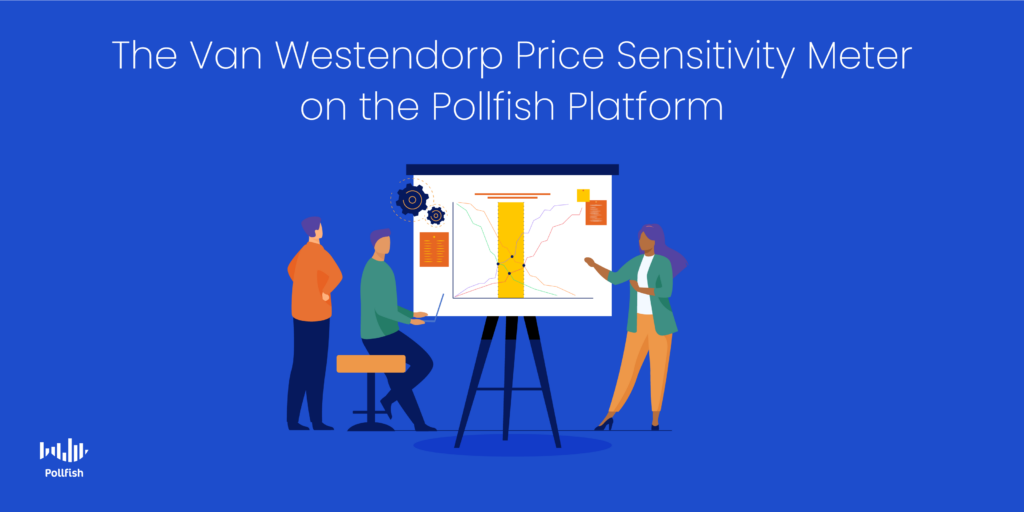
The Pollfish online platform presents the results of the PSA method in the aforementioned chart. The chart is a representation of the cumulative percentage of respondents/price.
The Price Sensitivity Meter appears as the following on the platform:
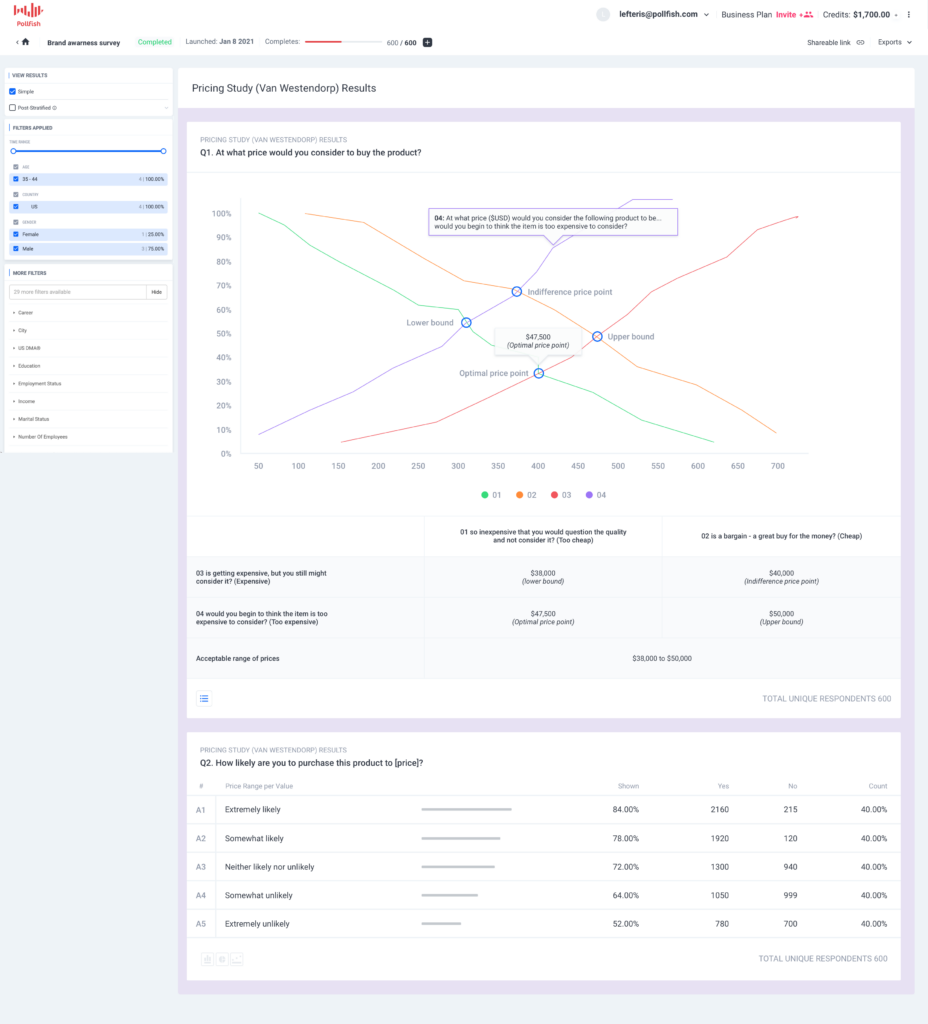
This chart is the outcome of the PSA approach, showing researchers the price range from the lower bound to the upper bound for the product/service. It also allows them to unearth the “optimal price” point and the “indifferent price point.”
This marks the end of the standard or basic PSM. However, the Pollfish platform offers an enhancement to this market research technique. This is called the Newton-Miller-Smith Extention.
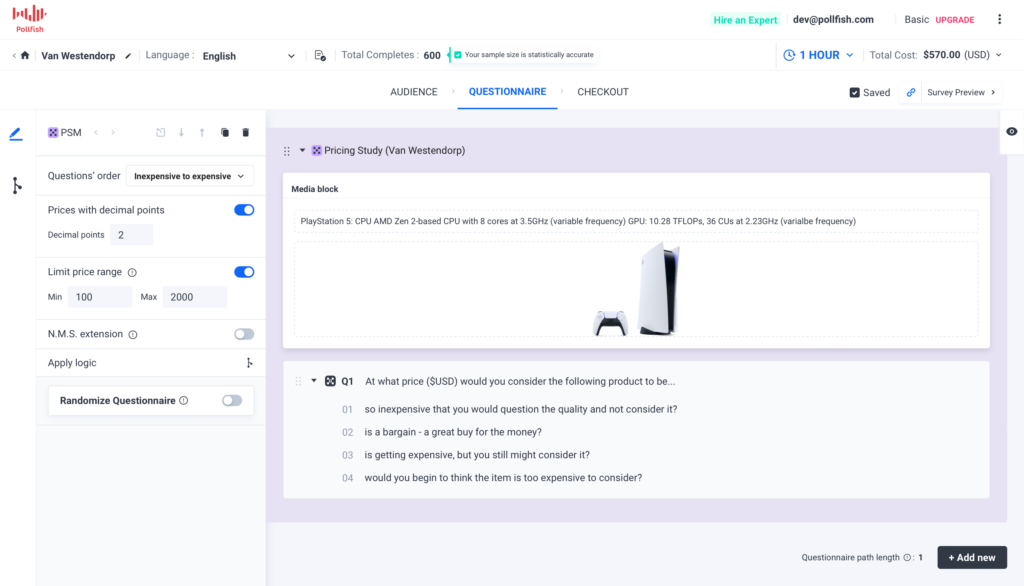
The NMS extension grants researchers the ability to add additional questions (2 or more) about the likelihood of customers purchasing the products and services they were shown/ asked about.
These questions will appear after the four Van Westendorp ones. They exist as rating scales. For example: “On a scale of 1-7, how likely are you to buy this product?”
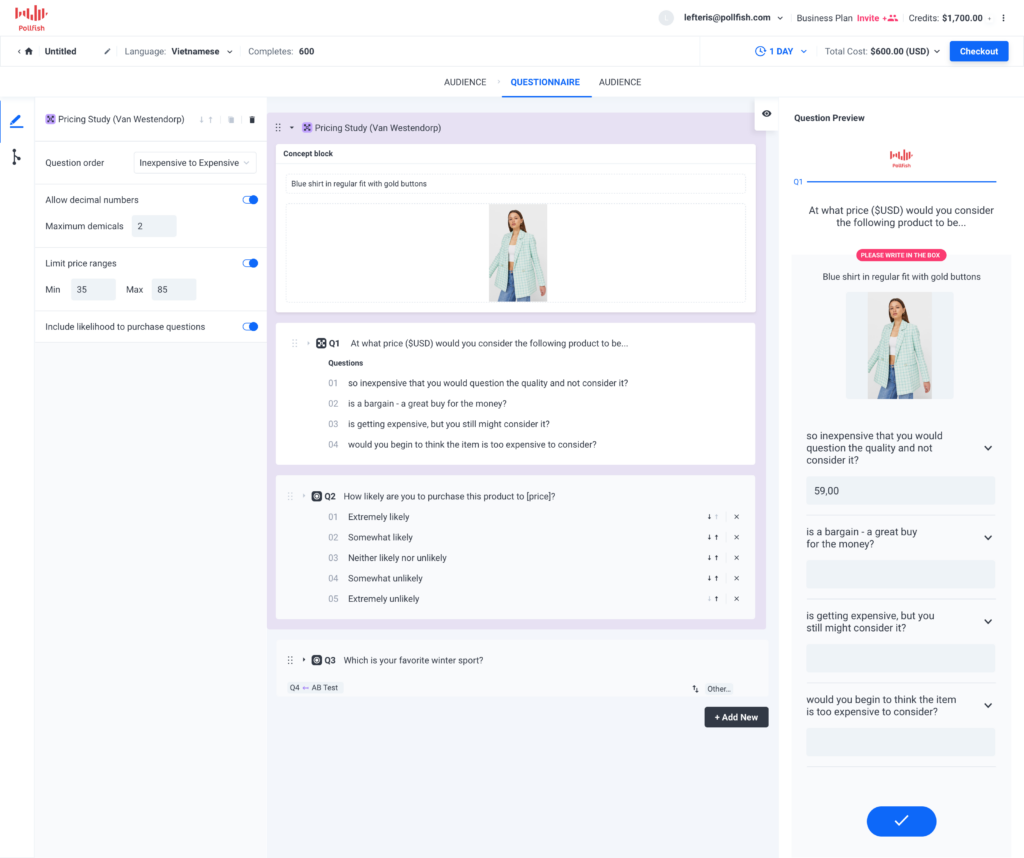
Ultimately, this extension allows researchers to not only understand customers’ sentiments towards price points, but to ascertain whether they will buy the products or not.
The Van Westendorp Price Sensitivity Meter Survey Questions
These questions remain the same in the PSA model. The following displays these survey questions: questions, which exist as numeric, open-ended survey questions.
- At what price would you consider the product to be priced so low that you would feel the quality couldn’t be very good?
- Discovers whether a price is too cheap
- At what price would you consider the product to be a bargain—a great buy for the money?
- Discovers whether a price is either on the cheaper end or a good value
- At what price would you consider the product starting to get expensive, so that it is not out of the question, but you would have to give some thought to buying it?
- Determines whether a price is expensive or on the upper pricing echelon.
- At what price would you consider the product to be so expensive that you would not consider buying it?
- Determines whether a price is too expensive or on the upper pricing echelon.
Using Advanced Skip Logic (2022 Update)
The Van Westendorp Pricing Meter now supports the usage of the Pollfish advanced skip logic feature. This valuable addition to the Price Sensitivity Meter enables you to route respondents to relevant follow-up questions based on their previous answers. Thus, you can create a deep dive into customers by asking them questions based on their specific answers from a prior question.
You can use advanced skip logic when a respondent exits the Van Westendorp PSM. This new capability strengthens and empowers the PSM to be more relevant and personalized to respondents’ survey experience.
Forming Optimal Pricing Strategies
Forming an optimal price strategy is difficult; this is compounded when you consider shifting expectations with new seasons. After all, you ought to stand out from your competitors by offering better prices, but also ensure that you’re not selling yourself short.
The Van Westendorp Price Sensitivity Meter allows you to do just that, saving you the guesswork and hesitation in setting prices across all your products and services. What’s best is that it is included in the Pollfish online survey platform.
Remember, you should use a market research platform that deploys surveys within a mass network of publishers, ones that account for major websites, apps and mobile sites, along with one that also grants you the ability to send surveys your own way.
A strong market research platform will also attract your survey audience with an appealing digital element that leads to your survey and easily grabs users’ attention. In addition, it will partner with publishers who gamify surveys, allowing respondents to gain incentives while playing a game, making the experience far from boring.
You should also opt for an online research platform that makes buying survey respondents a quick and simple process. This way, you’ll collect all your necessary data from the right respondents in a short space of time.
Additionally, use a platform that features artificial intelligence and machine learning to remove low-quality data and offer a broad range of survey and question types.
Applying an online survey platform with all of these capabilities will empower you to reach any survey audience and gain all of their thoughts on all price ranges, allowing you to form smarter and more effective pricing strategies.
Pollfish Marketing Team
Ready to Try Pollfish?
Create your survey with AI, target high-quality respondents starting at $0.95 per complete, and start getting results in just minutes in real-time. From running a simple product concept survey to managing a constant stream of trackers for dozens of clients in dozens of countries, we’ve got you.
